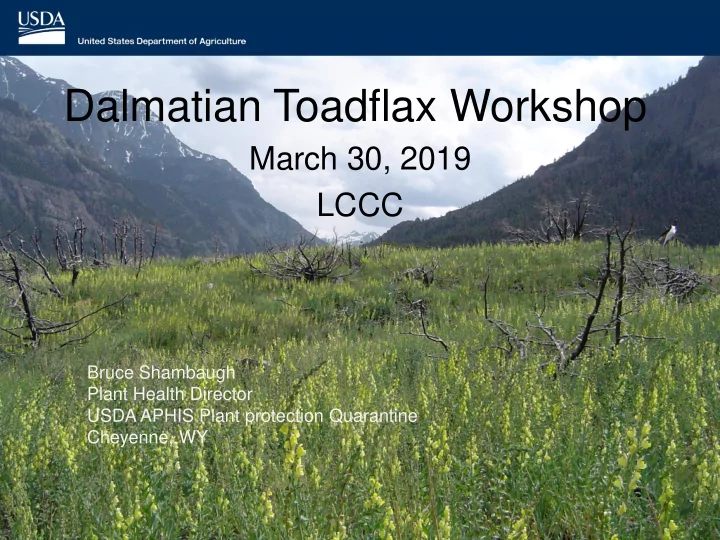

Dalmatian Toadflax Workshop March 30, 2019 LCCC Bruce Shambaugh Plant Health Director USDA APHIS Plant protection Quarantine Cheyenne, WY
Dalmatian Toadflax ( Linaria dalmatica ) • Upright, herbaceous perennial plant • Deep taproot with lateral roots • Flowers are bright yellow and snap-dragon like • Likes wastelands, roadsides, pastures, various elevations, etc.
Bio control agents for toadflaxes • Multiple agents with poor to excellent success • The first Bio agents for control of toadflax in North America were introduced accidently • Mecinus spp. (believed to be M. janthinus ) were released in USA in 1996 on both yellow and Dalmatian toadflaxes • M. janthiniformis was part of the USA release and practitioners recognize the different Mecinus species
Stem boring weevils – Mecinus janthiniformis & Mecinus janthinus • Mecinus janthinus – more effective on yellow toadflax • Mecinus janthiniformis – more effective on Dalmatian toadflax
Stem boring weevils – Mecinus janthiniformis & Mecinus janthinus • Mecinus species very similar • Larvae are white with brown head capsules, up to 5 mm long • Adults are bluish-black, with long snouts and are up to 5 mm long • If a Mecinus weevil is established on YTF, collect and release on YTF • If a Mecinus weevil is established on DTF, collect and release on DTF
Stem boring weevils – Mecinus janthiniformis & Mecinus janthinus • The rest of this discussion will concentrate on Mecinus janthiniformis on Dalmatian Toadflax.
Mecinus weevil lifecycle • Overwintering adults emerge in early spring and feed on shoot tips • Females chew holes in toadflax stems and lay eggs singly (up to 45 times in lifetime) • Hatching larvae feed in short tunnels chewed into toadflax stems • Pupation occurs in late summer within chambers inside the feeding tunnels • Adults overwinter inside pupal chambers
Mecinus Stem Boring weevils • One generation per year Damage: • Adult feeding stunts the shoots and roots and suppresses flowering • Larval mining severs water/nutrient conducting tissues, causing desiccation and death of the plant
Mecinus Stem Boring weevils Collection and redistribution: • Adults can be collected in the spring through mid summer, when plants are bolting to late flowering • Late May through the second week of July in WY • Adults should be readily visible, mating and congregating on shoot tips and leaf axils • Normally active in warm, calm, sunny weather
Sweeping for weevils
Mecinus Stem Boring weevils Collection and redistribution: • Collect adults by: • Knocking them from plants • sweeping • Aspirate adults directly from plants, sweep net or catch tub • Place adults in tight container with a few stems for redistribution
Aspirating weevils
Mecinus Stem Boring weevils Collection and redistribution: • Collect adults/larvae by: • Cutting infested stems in October – November • Place at a new release site • Collecting adults is most effective
Mecinus Stem Boring weevils Collection and redistribution: • Release suggestions: • 200 adults per release site • 20-25 infested stems per release site • Release sites ideally should be in areas with snow accumulation ad no/little chemical control
PPQ efforts PPQ has conducted releases, collections and redistributions across Wyoming since the late 1990s Release sites have had varied success PPQ has multiple locations where we can usually collect – field insectories
PPQ efforts PPQ has periodically received both Mecinus weevils from Montana and Colorado for release into Wyoming Concentrated releases in SE Wyoming in recent years Collected and maintained data
Place Your Text Here
Effectiveness of Mecinus janthiniformis Classical bio control can be quite effective but most often relatively slow to see large impact
Effectiveness of Mecinus janthiniformis • Abundant on Dalmatian toadflax in the USA and Canada • Reduced Dalmatian toadflax dramatically throughout most of its range • Have seen varied success in local areas
Effectiveness of Mecinus janthiniformis • Observed dramatic stand reductions over the years • Takes time – need to be patient • Can find some level of Mecinus on DTF throughout Laramie County
Effectiveness of Mecinus janthiniformis • Parasitism, cold climates, preferred micro habitats affect Mecinus establishment and success • Weather and climate events impact DTF stands so impact is difficult to measure from year to year
DTF Bio control - an IPM approach? • Bio control takes time, but may have long term impact • Caution should be used when mowing/grazing in areas where Mecinus has been released – larvae/pupae/adults are in the DTF stems
DTF Bio control - an IPM approach? • Select release sites in areas where chemical use is problematic (tree rows, etc.), very large DTF populations and in areas of snow accumulation. • Select release sites with Long term commitment to bio control – aversion to chemical use, next to tree rows, etc.
DTF Bio control - an IPM approach? • Potential long term strategy?: • Chemical control in a EDRR location or at leading edge of DTF populations – minimize the spread • Combine bio control and some chemical management within the larger areas of the DTF population – potential for long term, less expensive management • Utilize bio control in areas where not suitable for chemical control – any bio control will help the effort
Questions & Contacts: Bruce Shambaugh – USDA APHIS PPQ 5353 Yellowstone RD, Suite 208 Cheyenne, WY (307) 432 – 7979 Bruce.a.Shambaugh@usda.gov Kathleen King – USDA APHIS PPQ 5353 Yellowstone RD, Suite 208 Cheyenne, WY (307) 432 – 7979 Kathleen.m.king@usda.gov
Recommend
More recommend